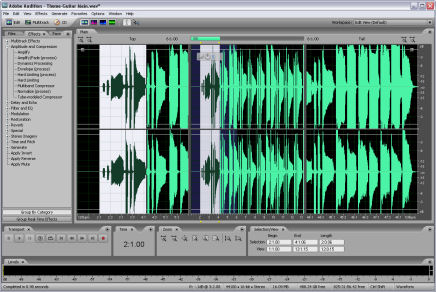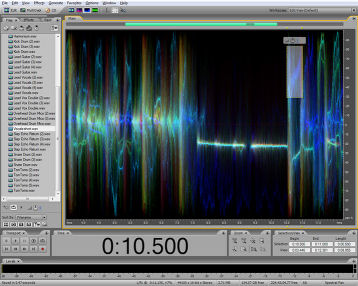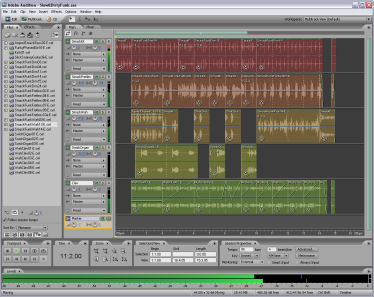Manifest Technology Blog
-- Site:
| Articles
| Galleries
| Resources
| DVI Tech
| About
| Site Map
|
Articles:
| PC Video
| Web Media
| DVD & CD
| Portable Media
| Digital Imaging
| Wireless Media
| Home Media
| Tech & Society
|
PC Video: |
PC Video Articles |
Video Software Gallery |
Video Editing Resources |
Adobe Audition 3 -
Professional Audio Editing and Mixing (4/2008)
by Douglas Dixon
Editing Audio with Video
Audition and Soundbooth
Adobe Audition 3
Waveform Editing
Spectral Editing
Making Music
References
See also: Summary: Adobe Audition 3 -
Audition vs. Soundbooth, New Features, Features Summary
We live in a video age -- we watch video, shoot video, edit video, and post
videos online. Yet if you're working on a video production, professional or just
for fun, you know that audio is a key element of the mix. Music is an important
part of our lives, especially with the popularity of MP3 players. And in
watching video, the audio quality is even more important than the video -- we
happily watch really low-res YouTube videos with blocky compression artifacts,
but can't stand it when the audio breaks up and cuts in and out.
Even more, when editing a video production, the audio is a key element of
establishing mood (with background music and sound effects), and in pulling us
in to the action (with clear dialog and crisp sound).
And this is true even if you're just making a quick home movie. Adding a
soundtrack under the titles and on the DVD menu makes your production much more
enjoyable. Or a little more work to add some background audio will go a long
way, with fun sound effects or musical emphasis. You may not be a Hollywood
movie maker, but your audiences are used to that level of production, and adding
audio highlights and emphasis can go a long way to making even your amateur
productions more interesting.
You can edit and enhance audio within your video editing software (like Adobe
Premiere Pro or Adobe Premiere Elements for consumers), but for more
sophisticated cleaning and filtering, and to mix soundtracks, you need to move
to a dedicated audio tool like Adobe Soundbooth or Adobe Audition.
Adobe has recently upgraded Audition to version 3, so we'll walk through it here
to show the range of capabilities you can use to create and enhance your audio.
While the focus here is on the Adobe suites of professional and consumer
software, Sony Creative Software has a similar product line, with Sony
Vegas Pro, Sound Forge and ACID Pro for professional editing,
and entry-level Home Studio versions of these applications for consumers
(www.sonycreativesoftware.com).
The first place to get started with enhancing your audio is in your video
editing tool. Even consumer tools like Adobe Premiere Elements allow you
to assemble audio clips, add fade transitions, change timing (speed up or slow
down), and apply audio filters and effects such as delay, noise removal, pitch
shift, and reverb (www.adobe.com/products/premiereel).
Beyond enhancing a single track, you also can add multiple overlay audio
tracks in your video editor (e.g., narration and soundtrack), and mix the volume
across all the tracks. You even can unlink the audio from a video clip in order
to process it separately, for example if it is out of sync.
All this is great if you have clean audio with your video to begin with, and
you have a library of music and sound effects ready to mix into your production.
But if the audio tracks need more work -- for example to remove a background
rumble or someone with a persistent cough -- or if you need to create additional
soundtrack or background music, then it's time to move on to a dedicated audio
tool.
Adobe Audition is a high-end audio editing tool, designed as a
all-in-one toolset for professional audio production -- to record audio, mix
multiple tracks, edit and enhance individual clips, and master the final
production (www.adobe.com/products/audition).
That can sound a bit intimidating to people who are not audio pros, although
Audition is rather straightforward to use with the familiar Adobe interface, and
has nice presets for its filters and effects that help you get started as you
work on a problem track.
A little history: Audition was originally released as part of the Adobe Video
Collection suite in May 2004, after Adobe acquired the former Cool Edit Pro
application from Syntrillium Software in May 2003. However, as Audition evolved
as a tool for audio professionals it outgrew the needs of the video and creative
professionals that were the focus of the Adobe Creative Suite 3 (www.adobe.com/products/creativesuite).
As a result, Adobe replaced Audition in the CS3 suite (released in mid-2007),
with a new audio tool, Adobe Soundbooth CS3, which provided task-based
tools for everyday audio editing and cleanup, sound design, and music creation (www.adobe.com/products/soundbooth).
Meanwhile, Adobe Audition continued as an independent application, and the
new Adobe Audition 3 was released at the end of 2007 as Adobe's flagship
stand-alone tool for professional audio production.
To distinguish the two applications:
- Adobe Soundbooth is part of the Adobe Creative Suite 3 family. It
provides a subset of Audition's features, designed for the needs of video
editors and creative professionals who are not audio professionals.
Soundbooth is not a multi-track mixing tool -- It is focused on single-clip
editing, with task-based tools for audio cleaning. It also includes
the AutoComposer for automatically generating scores in selected styles
to match existing clips. Soundbooth is available both for Windows and
Intel-based Macs.
- Adobe Audition is a stand-alone full audio toolset for
professional audio production. It's designed to take audio professionals
through the full workflow of recording, mixing, editing, and mastering
audio. It includes waveform editing of single clips, multi-track
mixing, looping, MIDI, with extensive effects and tools
for audio restoration and enhancement. Audition is available only for Windows.
 Soundbooth: Wave editing & effects
Soundbooth: Wave editing & effects
For creating music, Audition does not have the AutoComposer automatic score
generation feature in Soundbooth (like SmartSound Sonicfire, www.smartsound.com).
Instead it has extensive capabilities for creating loop-based music, and for
mixing recorded audio with loops and now MIDI music.
For more on Adobe Creative Suite 3
- See Adobe Creative Suite 3: Summary for
an overview of the CS3 applications, suites, and pricing
- See Adobe CS3 Production Suite: Summary
for more on the CS3 video and audio tools
For previous versions of Adobe Audition
- See Adobe Production Studio: First Look
for Audition 2.0
- See Audio Tools for Video Editors on Audition
1.0
For Soundbooth CS3
- See Adobe Soundbooth: Audio for Video
 Find Adobe
Audition 3 on Amazon.com
Find Adobe
Audition 3 on Amazon.com
[ Top ]
Adobe Audition 3 is not a huge
re-write or re-design of the product. Instead, it picks up a couple of the
enhancements in Soundbooth, and provides a broad range of significant
enhancements across the application, both to individual features, and in
enhanced performance and more efficient workflow.
 Audition: Multitrack mixing
Audition: Multitrack mixing
In particular, Audition 3 provides faster editing with direct on-clip
drag-and-drop editing as in Soundbooth. The amazing Frequency space / Spectral
editing view also now supports the Photoshop-like spectral editing Effects Paintbrush and Spot
Healing Brush.
It adds new effects including Convolution Reverb, Analog Delay, Mastering
tool, and Tube-modeled Compressor, along with iZotope time stretching. Plus
there's improved noise reduction and phase correction tools.
In addition, Audition now includes MIDI recording and mixing, with a piano
roll editor for MIDI tracks, using industry-standard VSTi virtual instruments.
Audition 3 is available for Windows XP and Vista for $349, or for a $99
upgrade from all past versions of Adobe Audition and Adobe Production Studio.
Audition starts up by default in the Multitask View, the multi-track
mixing mode where you can arrange many layers of tracks with recorded clips,
loops, and now MIDI music. But Audition is also a full-fledged editor for
individual tracks -- you can record new clips (and even multiple inputs, with
live monitoring), import clip files, or double-click on a track to switch to the
Edit View to work on individual waveforms.
 Multitrack view
Multitrack view
In the Waveform edit mode you can play though the clip, zoom in (even
to see and edit the individual samples), and quickly cut and paste sections.
 Waveform editing
Waveform editing
Audition 3 also adds several convenience features for faster editing. The
direct waveform editing tools appear as floating on-clip controls, so you can
adjust the volume for the selected portion of a waveform and add fades with
on-clip click-and-drag handles. Similarly, the clever Top/Tail view zooms into
the beginning and the end of a loop or clip to help you quickly add precise
fades, while keeping the whole file in view in the scrolling center region.
Beyond straightforward editing, Audition includes more than 50 audio
effects,
including analysis and restoration tools to correct and enhance difficult clips.
It also supports third-party VST and DirectX plug-ins. You can apply the effects
individually, using presets and previews to check the results, or use the
Mastering Rack to apply and preview multiple effects simultaneously.
For example, you can restore recordings from old vinyl records, remove hisses
and hums, and fix clipped audio and phase problems. Other cool features include
pitch correction to correct off-pitch performances, and vocal/instrumental
extraction to create a cappella or karaoke-ready tracks.
Audition 3 has new audio healing and selection tools to edit or remove
specific sounds or certain frequencies, Adaptive Noise Reduction to find and
remove unwanted noise that changes over time, and Automatic Phase Correction to
align the channels of a stereo waveform. There's also a new suite of
analog-modeled filter and distortion guitar effects, to use with guitars or
other instruments.
Plus, Audition 3 includes iZotope time stretching to speed up or slow down a
clip, altering tempo without changing the pitch, or changing pitch without tempo
distortion.
Editing waveforms is fun, and somewhat intuitive, but it gets messy when
there are multiple sources mixed up together in the single waveform -- multiple
instruments and vocals, much less background noise from the venue, or hum from
the air conditioners, or other unfortunate glitches like somebody coughing in
the audience or the ring of a cell phone. When you have a real-world recording,
or a mixed production, you can no longer isolate a particular element or sample
to edit -- Or can you?
This is the beauty of Audition's amazing Spectral Frequency Display view,
which allows you to analyze your clips by visualizing the frequency over time
(or pan or phase), so you can distinguish voices, instruments, and transients.
Even better, if you can see it, you can edit it -- you actually can apply your
familiar Photoshop editing experience to working on audio.
 Spectral frequency view
Spectral frequency view
Use the new lasso tool to make free-form selections in frequency space to
isolate specific sounds, then use the new Effects Paintbrush to apply effects to
the selection, or apply the new Spot Healing Brush to smooth over a region and
automatically repair clicks, pops, and other noises. You can even import and
export the Spectral Bitmap to actually edit audio in Adobe Photoshop.
Multitrack Mixing & MIDI
Once you've cleaned up your individual audio clips, you can use Audition's Multitrack
View to combine them into the final mix.
Audition also supports loop-based
soundtrack creation, so you can arrange, extend, and mix loops that
automatically match the global session tempo and key. The product includes a
library of some 5,000 uncompressed, 32-bit, royalty-free loops, plus 20
royalty-free music beds, at 15- and 30-second lengths.
 Mixing Loops
Mixing Loops
As in the waveform view, Audition 3 includes helpful interface enhancements
for faster editing, including mixing by dragging clips, ripple delete, and
grouping to trim and delete, split, add fades across multiple tracks. There's
also a new batch feature to apply specific formats, locations, and filename
templates to a group of files.
The big addition in Audition is MIDI editing, with the MIDI piano roll
editor and support for industry-standard VSTi virtual instruments. You can
control and read from attached MIDI devices including synthesizers and
keyboards, and edit note, velocity, and controller values in the piano roll
editor.
 MIDI piano roll editor
MIDI piano roll editor
While Audition is not designed as a full-up MIDI sequencer, it provides
enough support to now record, edit, and mix MIDI into your productions.
 MIDI mixing
MIDI mixing
As you can see, there's a lot to Audition. Audio professionals can dive in
and harness the power, but Audition also can be useful for less audio-centric
video editors who need to work more deeply with their audio. For example, while
Soundbooth provides nice task-based tools for audio cleanup, Audition offers a
broader range of more powerful tools, with both quick-to-use presets and
extensive custom parameters. And if you need custom royalty-free soundtracks for
your production, while Soundbooth's AutoComposer automatic score generation tool
is a quick solution, Audition gives you much more creative freedom to mix
loop-based tracks, for example with drum emphasis to sync to an imported video
clip.
Audition 3 also includes support for surround sound, more than 20
file formats, high-quality sample rate conversions (for CD, video,
and DVD), and extensive mastering tools for the final mixdown. Plus,
Adobe has enhanced the performance of Audition 3, especially to take advantage
of new multi-core processors, so the optimized mixing engine supports more
tracks and effects and increased complexity on the same machine.
Audition is designed as a complete toolset for professional audio production
-- to record, mix, edit, and master -- but it also is accessible to video
editing types who want to dig deeper and be more creative with their audio. And,
it's tightly integrated with the Adobe CS3 suite to fit well into existing
workflows. The upgrade to version 3 adds both useful new capabilities and more
intuitive editing controls. Use it to clean up old tape and vinyl tracks,
sweeten live recordings and voice-overs, design your own music mixes ... and
much more.
You can try out Adobe Audition (and Soundbooth) by downloading free trial
versions from the Adobe website.
Adobe Audition 3
www.adobe.com/products/audition
Adobe Soundbooth CS3
www.adobe.com/products/soundbooth
Adobe Creative Suite 3
www.adobe.com/products/creativesuite
Adobe Premiere Pro
www.adobe.com/products/premiere
Adobe Premiere Elements
www.adobe.com/products/premiereel
Sony Creative Software
www.sonycreativesoftware.com
SmartSound Sonicfire
www.smartsound.com
[ Top ]
Portions originally published in Camcorder
& Computer Video magazine, 24, 2, April 2008.
|
